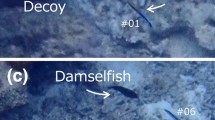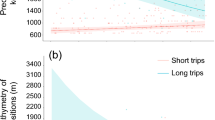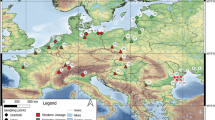Synopsis
Behavioral responses to predators can have a major impact on a fishes' diet and habitat choice. Studies with the bluegill sunfish, Lepomis macrochirus, demonstrate that bluegills undergo pronounced shifts in diet and habitat use as they grow in response to changes in their vulnerability to predators. Other species of fish exhibit similar habitat shifts with body size, presumably also in response to changing predation risks and/or foraging gains. An important but little appreciated consequence of this type of predator-mediated habitat use is that predation risk, by structuring size and/or age-specific resource use, may also indirectly affect species interactions. This paper discusses some of the ways in which behavioral responses to predators may affect intra- and interspecific competition in fish. Observational and experimental studies with sunfish (Centrarchidae) provide most of the examples. These studies suggest that the ‘nonlethal’ effects of predators may be as important as the actual killing of prey.
Similar content being viewed by others
References cited
Abrams, P.A. 1984. Foraging time optimization and interactions in food webs. Amer. Nat. 124: 80–96.
Backiel, T. & E.D. LeCren. 1967. Some density relationships for fish population parameters. pp. 279–302 In: S.D. Gerking(ed.) Ecology of Freshwater Fish Production, J. Wiley and Sons, New York.
Bagenal, T.B. 1978. Aspects of fish fecundity. pp. 75–101. In: S.D. Gerking(ed.) Ecology of Freshwater Fish Production, J. Wiley and Sons, New York.
Beyerle, G.B. & J. Williams. 1972. Survival, growth, adn production by gluegills subjected to population reduction in ponds. Michigan Department of Natural Resources Development Report 273. 28 pp.
Bray, R.N. 1981. The influence of water currents and zooplankton densities on daily foraging movements of blacksmith, Chromic punctipinnis, a planktivorous reef fish. U.S. Fish. Bull. 78: 829–841.
Brooks, J.L. & S.J. Dodson. 1965. Predation, body size and composition of plankton. Science 150: 28–35.
Carlander, K.D. 1977. Handbook of freshwater fishery biology. Volume two. The Iowa State University Press, Ames. 431 pp.
Caraco, T., S. Martindale & H.R. Pulliam. 1980. Avian time budgets and distance to cover. Auk 97: 872–875.
Caswell, H. 1978. Predator-mediated coexistence: a nonequilibrium model. Amer. Nat. 112: 127–154.
Cerri, R.D. & D.F. Fraser. 1983. Predation and risk in foraging minnows: balancing conflicting demands. Amer. Nat. 121: 552–561.
Connell, J.H. 1975. Some mechanisms producing structure in natural communities. A model and some evidence from field experiments. pp. 460–492. In: M.L. Cody & J.M. Diamond(ed.) Ecology and Evolution of Communities, Belknap Press, Cambridge.
Connell, J.H. 1983. On the prevelance and relative importance of interspecific competition: evidence from field experiments. Amer. Nat. 122: 661–696.
Cooper, E.L., C.C. Wagner & G.E. Krantz. 1971. Bluegills dominate production in a mixed population of fishes. Ecology 52: 280–290.
Cooper, S.D. 1984. The effects of trout on water striders in stream pools. Oecologia 63: 376–379.
Cushing, D.H. 1976. Biology of fishes in the pelagic community. pp. 317–340. In: D.H. Cushing & J.J. Walsh(ed.) The Ecology of the Seas, W.B. Saunders Co., Philadelphia.
Cushing, D.H. 1982. Climate and fisheries. Academic Press, New York. 373 pp.
Dayton, P.K. 1971. Competition, disturbance, and community organization: the provision and subsequent utilization of space in a rocky intertidal community. Ecol. Monog. 41: 351–389.
Dill, L.M. & A.H.G. Fraser. 1985. Risk of predation and the feeding behavior of juvenile coho salmon (Oncorhynchus kisutch). Behav. Ecol. Sociobiol. 16: 65–72.
Dillard, J.G. & G.D. Novinger. 1975. Stocking largemouth bass in small impoundments. pp. 459–479. In: H. Clepper(ed.) Black Bass Biology and Management, Sport Fishing Institute, Washington, D.C.
Ebeling, A.W. & D.R. Laur. 1985. The influence of plant cover on surfperch abundance at an offshore temperate reef. Env. Bio. Fish. 12: 169–179.
Edwards, J. 1983. Diet shifts in moose due to predator avoidance. Oecologia 60: 185–189.
Egglishaw, H.J. & P.E. Shackley. 1977. Growth, survival and production of juvenile salmon and trout in a Scottish stream, 1966–1975. J. Fish Biol. 11: 647–672.
Elliott, J.M. 1984. Numerical changes and population regulation in young migratory trout Salmo trutta in a Lake District stream 1966–1983. J. Anim. Ecol. 53: 327–350.
Fisher, M.E. & B.D. Goh. 1977. Stability in a class of discrete time models of interacting populations. J. Math. Biol. 4: 265–274.
Gerking, S.D. 1966. Annual growth cycle, growth potential, and growth compensation in the bluegill sunfish in northern Indiana lakes. J. Fish. Res. Board Can. 23: 1923–1956.
Gilliam, J.F. 1982. Habitat use and competitive bottlenecks in size-structured fish populations. Ph.D. Dissertation, Michigan State University, East Lansing. 107 pp.
Glass, N.R. 1971. Computer analysis of predation energetics in the largemouth bass. pp. 325–363. In: B.C. Patten (ed.) Systems Analysis and Simulation in Ecology, Volume 1, Academic Press, New York.
Holt, R.D. 1977. Predation, apparent competition and the structure of prey communities. Theor. Pop. Biol. 12: 197–229.
Holt, R.D. 1984. Spatial heterogeneity, indirect interactions, and the coexistence of prey species. Amer. Nat. 124: 377–406.
Jackson, P.B.N. 1961. The impact of predation especially by the tiger fish (Hydrocynus vittatus Cast.) on African freshwater fishes. Proc. Zool. Soc. Lond. 136: 603–622.
Jones, G.P. 1984. The influence of habitat and behavioral interactions on the local distribution of the wrasses, Pseudolabrus celidotus. Env. Biol. Fish. 10: 43–58.
Keast, A. 1978. Feeding interrelations between age groups of pumpkinseed sunfish (Lepomis gibbosus) and comparisons with the bluegill sunfish (L. macrochirus). J. Fish. Res. Board Can. 35: 12–27.
Kitchell, J.F., J.F. Koonce, R.V. O'Neill, H.H. Shugart, Jr., J.T. Magnuson & R.S. Booth. 1974. Model of fish biomass dynamics. Trans. Amer. Fish. Soc. 103: 786–798.
Larkin, P.A. 1977. Fisheries management — an essay for ecologists. Ann. Rev. Ecol. System. 9: 57–73.
Lasker, R. 1981(ed.). Marine fish larvae: morphology, ecology and relation to fisheries. Washington Sea Grant Program, Seattle. 131 pp.
Laughlin, D.R. 1979. Resource and habitat use patterns in two coexisting sunfish species (Lepomis gibbosus and Lepomis megalotis peltastes). Ph.D. Dissertation, Michigan State University, East Lansing. 92 pp.
LeCren, E.D. 1962. The efficiency of reproduction and recruitment in freshwater fish. pp. 283–296. In: E.D. LeCren & H.W. Holdgate(ed.) The Exploitation of Natural Animal Populations, Blackwell Scientific, Oxford.
LeCren, E.D. 1965. Some factors regulating the size of populations of freshwater fish. Mitt. Internat. Verein. Limnol. 13: 88–105.
Leggett, W.C. 1977. Density dependence, density independence, and recruitment in the American shad (Alsoa sapidissima) population in the Connecticut River. pp. 3–17. In: W. VanWinkle(ed.) Assessing the Effects of Power-Plant-Induced Mortality in Fish Populations, Pergamon Press, New York.
Lett. P.F. 1980. A comparative study of the recruitment mechanisms of cod and mackerel, their interaction, and its implication for dual stock assessment. Can. Tech. Rep. Fish. Aquat. Sci. 988. vi + 45 pp.
Levine, S.H. 1976. Competition interactions in ecosystems. Amer. Nat. 110: 903–910.
Lima, S.L., T.J. Valone & T. Caraco. 1985. Foraging efficiency-predation risk tradeoff in the grey squirrel. Anim. Behav. 33: 155–165.
Lindstrom, T. & N.-A. Nilsson, 1962. On the competition between whitefish species. pp. 326–340. In: E.D. LeCren & H.W. Holdgate(ed.) The Exploitation of Natural Animal Populations, Blackwell Scientific, Oxford.
Lubchenco, J. 1978. Plant species diversity in a marine intertidal community: importance of herbivore preference and algal competitive abilities. Amer. Nat. 112: 23–39.
Maiorana, V.C. 1976. Predation, submergent behavior, and tropical diversity. Evol. Theor. 1: 157–177.
May, R.M. & G.F. Oster. 1976. Bifurcations and dynamic complexity in simple ecological models. Amer. Nat. 110: 573–599.
McCabe, G.T. Jr., W.D. Muir, R.L. Emmett & J.T. Durkin. 1983. Interrelationships between juvenile salmonids and nonsalmonid fish in the Columbia River estuary. U.S. Fish. Bull. 81: 815–826.
McFadden, J.T. 1977. An arguement supporting the reality of compensation in fish and a plea to let them exercise it. pp. 153–183. In: W. VanWinkle(ed.) Assessing the Effects of Power-Plant-Induced Mortality in Fish Populations, Pergamon Press, New York.
Menge, B.A. 1976. Organization of the New England rocky intertidal community: role of predation, competition and environmental heterogeneity. Ecol. Monog. 46: 335–369.
Mercer, M.C. (ed.) 1982. Multispecies approaches to fisheries management advice. Can. Spec. Publ. Fish. Aquat. Sci. 59. 169 pp.
Milinski, M. & R. Heller. 1978. Influence of a predator on the optimal foraging behavior of sticklebacks (Gasterosteus aculeatus L.). Nature 275: 642–644.
Mittelbach, G.G. 1981. Foraging efficiency and body size: a study of optimal diet and habitat use by bluegills. Ecology 62: 1370–1386.
Mittelbach, G.G. 1983. Optimal foraging and growth in bluegills. Oecologia 59: 157–162.
Mittelbach, G.G. 1984. Predation and resource partitioning in two sunfishes (Centrarchidae). Ecology 65: 499–513.
Mittelbach, G.G. & P.L. Chesson. 1985. Predation risk: indirect effects on fish populations. In: W.C. Kerfoot & A. Sih (ed.)Predation: Direct and Indirect Impacts on Aquatic Communities, New England University Press (in press).
Morin, P.J. 1983. Predation, competition, and the composition of larval anuran guilds. Ecol. Monog. 53: 119–138.
Murdoch, W.W. & A. Sih. 1978. Age-dependent interference in a predatory insect. J. Anim. Ecol. 47: 581–592.
Murton, R.K. 1971. Why do some bird species feed in flocks? Ibis 113: 534–536.
Neill, W.E. 1975. Experimental studies of microcrustacean competition, community composition and efficiency of resource utilization. Ecology 56: 809–826.
Nikol'skii, G.V. 1962. On some adaptations to the regulation of population density in fish species with different types of stock structure. pp. 265–282. In: E.D. LeCren & H.W. Holdgate(ed.) The Exploitation of Natural Animal Populations, Blackwell Scientific, Oxford.
Paine, R.T. 1966. Food web complexity and species diversity. Amer. Nat. 100: 65–75.
Parker, R.A. 1958. Some effects of thinning on a population of fishes. Ecology 39: 304–317.
Power, M.E. 1984. Depth distributions of armored catfish: predator-induced resource avoidance? Ecology 65: 523–529.
Power, M.E., W.J. Matthews & A.J. Stewart. 1985. Grazing minnows, piscivorous bass and stream algae: dynamics of a strong interaction. Ecology (in press).
Ricker, W.E. 1954. Stock and recruitment. J. Fish. Res. Board Can. 11: 559–623.
Ricker, W.E. 1979. Growth rates and models. pp. 677–743. In: W.S. Hoar, D.J. Randall & J.R. Brett (ed.) Fish Physiology, Vol. 8, Academic Press, New York.
Ricker, W.E. & R.E. Foerster. 1948. Computation of fish production. Bulletin Bingham Oceanographic Collection 11: 173–211.
Rosenkranz, G. 1983. On global stability of discrete population models. Math. Biosci. 64: 227–231.
Savino, J.F. & R.A. Stein. 1982. Predator-prey interaction between largemouth bass and bluegills as influenced by simulated, submersed vegetation. Trans. Amer. Fish. Soc. 111: 255–266.
Schmitt, R.J. 1982. Consequences of dissimilar defenses against predation in a subtidal marine community. Ecology 63: 1588–1601.
Schmitt, R.J. & S.J. Holbrook. 1985. Patch selection by juvenile black surfperch (Embiotochidae) under variable risk: interactive influence of food quality and structural complexity. J. Exp. Mar. Biol. Ecol. (in press).
Schoener, T.W. 1970. Nonsynchronous spatial overlap of lizards in patchy habitats. Ecology 51: 408–418.
Schopka, S.A. & G. Hempel. 1973.
Seaburg, K.G. & J.B. Moyle. 1964. Feeding habits, digestion rates, and growth of some Minnesota warm water fishes. Trans. Amer. Fish. Soc. 93: 269–285.
Sih, A. 1980. Optimal behavior: can foragers balance two conflicting demands? Science 210: 1041–1043.
Sih, A. 1982. Foraging strategies and the avoidance of predation by an aquatic insect, Notonecta hoffmanni. Ecology 63: 786–796.
Stamps, J.A. 1983. The relationship between ontogenetic habitat shifts, competition and predator avoidance in a juvenile lizard (Anolis aeneus). Behav. Biol. Sociobiol. 12: 19–33.
Stein, R.A. & J.J. Magnuson. 1977. Behavioral response of crayfish to a fish predator. Ecology 58: 571–581.
Swingle, H.S. & E.V. Smith. 1940. Experiments on the stocking of fish ponds. Trans. Amer. Wild. Con. 5: 267–276.
Ware, D.M. 1975. Relation between egg size, growth, and natural mortality of larval fish. J. Fish. Res. Board Can. 32: 2503–2512.
Ware, D.M. 1980. Bioenergetics of stock and recruitment. Can. J. Fish. Aquat. Sci. 37: 1012–1024.
Weatherley, A.H. 1972. Growth and ecology of fish populations. Academic Press, New York. 293 pp.
Wenger, A. 1972. A review of the literature concerning largemouth bass stocking techniques. Technical Series Number 13, Texas Parks and Wildlife Department, Sheldon.
Werner, E.E. 1974. The fish size, prey size, handling time relation in several sunfishes and some implications. J. Fish. Res. Board Can. 31: 1531–1586.
Werner, E.E. 1985. Species interactions in freshwater fish communities. In: J.M. Diamond & T. Case (ed.) Ecological Communities, Harper and Row (in press).
Werner, E.E. & J.F. Gilliam. 1984. The ontogenetic niche and species interactions in size-structured populations. Ann. Rev. Ecol. Syst. 15: 393–426.
Werner, E.E., J.F. Gilliam, D.J. Hall & G.G. Mittelbach. 1983a. An experimental test of the effects of predation risk on habitat use in fish. Ecology 64: 1540–1548.
Werner, E.E., G.G. Mittelbach, D.J. Hall & J.F. Gilliam. 1983b. Experimental tests of optimal habitat use in fish: the role of relative habitat profitability. Ecology 64: 1525–1539.
Werner, E.E., D.J. Hall, D.R. Laughlin, D.J. Wagner, L.A. Wilsmann & F.C. Funk. 1977. Habitat partitioning in a freshwater fish community. J. Fish. Res. Board Can. 34: 360–370.
Yodzis, P. 1976. The effects of harvesting on competitive systems. Bull. Math. Biol. 38: 97–109.
Author information
Authors and Affiliations
Rights and permissions
About this article
Cite this article
Mittelbach, G. Predator-mediated habitat use: some consequences for species interactions. Environ Biol Fish 16, 159–169 (1986). https://doi.org/10.1007/BF00005168
Received:
Accepted:
Issue Date:
DOI: https://doi.org/10.1007/BF00005168




